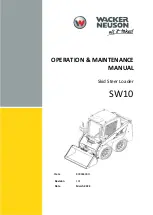
E 19
0
406
.GB
4
Industrial truck operation
4.1
Safety regulations for truck operation
Travel routes and work areas:
Only use lanes and routes specifically designated for
truck traffic. Unauthorised third parties must stay away from work areas. Loads must
only be stored in places specially designated for this purpose.
Travel conduct:
The driver must adapt the travel speed to local conditions. The truck
must be driven at slow speed when negotiating bends or narrow passageways, when
passing through swing doors and at blind spots. The driver must always observe an
adequate braking distance between the forklift truck and the vehicle in front and must
be in control of the truck at all times. Abrupt stopping (except in emergencies), rapid
U turns and overtaking at dangerous or blind spots are not permitted. It is forbidden
to lean out of or reach beyond the working and operating area.
Travel visibility:
The driver must look in the direction of travel and must always have
a clear view of the route ahead. Loads which affect visibility must be positioned at the
rear of the truck, or else the truck must reverse. If this is not possible, a second person
must walk in front of the truck as a lookout.
Negotiating slopes and inclines:
Negotiating slopes or inclines is only permitted if
such roads are clean and have a non-slip surface and providing such journeys are
safely undertaken in accordance with the technical specifications for the truck in
question. The truck must always be driven with the load unit facing uphill. The
industrial truck must not be turned, operated at an angle or parked on inclines or
slopes. Inclines must only be negotiated at slow speed, with the driver ready to brake
at any moment.
Negotiating lifts and docks:
Lifts and docks must only be used if they have sufficient
capacity, are suitable for driving on and authorised for truck traffic by the owner. The
driver must satisfy himself of the above before entering these areas. The truck must
enter lifts with the load in front and must take up a position which does not allow it to
come into contact with the walls of the lift shaft. .
People travelling in the lift with the forklift truck must only enter the lift after the truck
has come to a halt and must exit the lift before the truck.
Type of loads to be carried:
The operator must make sure that the load is in a
satisfactory condition. Do not carry loads unless they are positioned safely and
carefully. Use suitable precautions, e.g. a load guard, to prevent parts of the load from
tipping or falling down.
Summary of Contents for DFG 316
Page 1: ...Operating instructions 51011137 DFG TFG 316 320 G 04 06 02 07...
Page 3: ...0108 GB...
Page 7: ...0406 GB I 4...
Page 9: ...0406 GB A 2...
Page 15: ...0207 GB B 6...
Page 17: ...0207 GB B 8...
Page 25: ...0207 GB B 16...
Page 29: ...0406 GB C 4...
Page 69: ...0406 GB E 36...




































